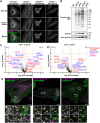When less is more - a fast TurboID knock-in approach for high-sensitivity endogenous interactome mapping
- PMID: 39056144
- PMCID: PMC11385326
- DOI: 10.1242/jcs.261952
When less is more - a fast TurboID knock-in approach for high-sensitivity endogenous interactome mapping
Abstract
In recent years, proximity labeling has established itself as an unbiased and powerful approach to map the interactome of specific proteins. Although physiological expression of labeling enzymes is beneficial for the mapping of interactors, generation of the desired cell lines remains time-consuming and challenging. Using our established pipeline for rapid generation of C- and N-terminal CRISPR-Cas9 knock-ins (KIs) based on antibiotic selection, we were able to compare the performance of commonly used labeling enzymes when endogenously expressed. Endogenous tagging of the µ subunit of the adaptor protein (AP)-1 complex with TurboID allowed identification of known interactors and cargo proteins that simple overexpression of a labeling enzyme fusion protein could not reveal. We used the KI strategy to compare the interactome of the different AP complexes and clathrin and were able to assemble lists of potential interactors and cargo proteins that are specific for each sorting pathway. Our approach greatly simplifies the execution of proximity labeling experiments for proteins in their native cellular environment and allows going from CRISPR transfection to mass spectrometry analysis and interactome data in just over a month.
Keywords: Gene editing; Membrane trafficking; TurboID.
© 2024. Published by The Company of Biologists Ltd.
Conflict of interest statement
Competing interests The authors declare no competing or financial interests.
Figures





References
-
- Abramoff, M., Magalhães, P. and Ram, S. J. (2004). Image processing with ImageJ. Biophotonics Intern. 11, 36-42.
-
- Banerjee, S. L., Lessard, F., Chartier, F. J. M., Jacquet, K., Osornio-Hernandez, A. I., Teyssier, V., Ghani, K., Lavoie, N., Lavoie, J. N., Caruso, M.et al. (2022). EPH receptor tyrosine kinases phosphorylate the PAR-3 scaffold protein to modulate downstream signaling networks. Cell Rep. 40, 111031. 10.1016/j.celrep.2022.111031 - DOI - PubMed
-
- Bogdanovic, A., Bennett, N., Kieffer, S., Louwagie, M., Morio, T., Garin, J., Satre, M. and Bruckert, F. (2002). Syntaxin 7, syntaxin 8, Vti1 and VAMP7 (vesicle-associated membrane protein 7) form an active SNARE complex for early macropinocytic compartment fusion in Dictyostelium discoideum. Biochem. J. 368, 29-39. 10.1042/bj20020845 - DOI - PMC - PubMed
Publication types
MeSH terms
Grants and funding
LinkOut - more resources
Full Text Sources
Research Materials

